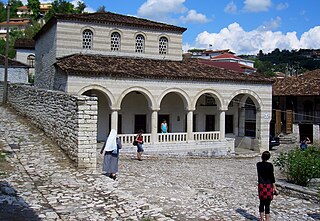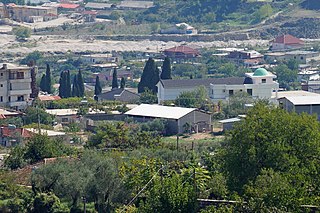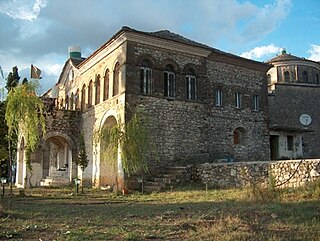Related Research Articles

The Bektashi Order or Bektashism is an Islamic Sufi mystic order originating in the 13th-century Ottoman Empire. It is named after the saint Haji Bektash Veli. The Bektashian community is currently led by Baba Mondi, their eighth Bektashi Dedebaba and headquartered in Tirana, Albania. Collectively, adherents of Bektashism, are called Bektashians or simply Bektashis.
Teke or Tekke can refer to:

The Halveti Tekke is a Cultural Monument of Albania, located in Berat. The teqe was built in 1782 from Ahmet Kurt Pasha and pertained to the Khalwati order, a Sufi sect.
The Rufai Tekke or Sheikh Riza Tekke is a Cultural Monument of Albania, located in Berat and pertaining to the Rüfai Sufi order. The teqe was built in the 18th century by Ahmet Kurt Pasha and pertained to the Rüfai, a Sufi order.
The Sheh Dyrri Tekke or Sheikh Duri Tekke is a teqe in Tirana, Albania. It is a Cultural Monument of Albania.

The Zall Tekke or Asim Baba Tekke is a Bektashi teqe in Gjirokastër, Albania. It is a Cultural Monument of Albania.

The Tekke of Frashër or Nasibî Tâhir Baba Tekke is a Bektashi shrine and Albanian Bektashi tekke founded in 1781 and registered Cultural Monument of Albania, located in Frashër, Gjirokastër County in southern Albania. The tekke was crucial to the Albanian National Awakening, particularly in the nationalist movements of the late 19th century, and it was one of the wealthiest and revered tekkes in Albania.

The Tekke of Dollmë or Haxhi Mustafa Baba Tekke is a Cultural Monument of Albania, located in Lagjja Kala, Krujë. Before its destruction by the Communist dictatorship, the tekke of Krujë had 360 holy graves and was known as "Little Khorasan".
The Tekke of Martanesh or Peshku Teqe(Teqeja e Peshkut) is a Cultural Monument of Albania, located in Martanesh, Dibër County.

Kasim Baba, also Kasem Baba, was a fifteenth century Bektashi religious figure and missionary. In Albania, he is venerated as a Muslim saint.
Reshat Bardhi was an Albanian religious leader who served as the 7th kryegjysh or Dedebaba of the Bektashi Order from 1991 to 2011.

Islamic monuments in Kosovo are commonly related with the Ottoman arrival in 1389, and respectively with their effective establishment in Kosovo in 1459. However, many historical evidences show that the first encounters of Islam with the Balkans happened well before the arrival of the Ottomans and their establishment in the Balkans. Because of its proximity to the centers of Islam, i.e., Middle East, the Byzantine Empire and parts of the Balkans, including the Albanian territories and Kosovo as well, were exposed to Islam as early as in the 8th century.

The Kosovan city of Gjakova has been populated since the prehistoric era. During the medieval period, in 1485, Gjakova is mentioned as a village, concretely as a market place.
Gjakova served as a trading center on the route between Shkodër and Istanbul.

Nasibi Tahir Babai, born Tahir Skënderasi, was an Albanian Bektashi wali and bejtexhi.

Islam in Communist Albania (1945–1991) covers a period of time when the Communist Party of Albania came to power under Enver Hoxha and exercised almost total control over the Albanian people. The communist government sought to radically overhaul Albanian society by realigning social, cultural and religious loyalties to the communist party through Albanian Nationalism in the pursuit of achieving unitary Albanian identity.

The architectural heritage of the Kosovo Albanians during Yugoslav rule was shown institutionalised disregard for decades prior to outright conflict at the end of the 20th century. Numerous Albanian cultural sites in Kosovo were destroyed during the period of Yugoslav rule and especially the Kosovo conflict (1998-1999) which constituted a war crime violating the Hague and Geneva Conventions. In all, 225 out of 600 mosques in Kosovo were damaged, vandalised, or destroyed alongside other Islamic architecture during the conflict. Additionally 500 Albanian owned kulla dwellings and three out of four well-preserved Ottoman period urban centres located in Kosovo cities were badly damaged resulting in great loss of traditional architecture. Kosovo's public libraries, of which 65 out of 183 were completely destroyed, amounted to a loss of 900,588 volumes, while Islamic libraries sustained damage or destruction resulting in the loss of rare books, manuscripts and other collections of literature. Archives belonging to the Islamic Community of Kosovo, records spanning 500 years, were also destroyed. During the war, Islamic architectural heritage posed for Yugoslav Serb paramilitary and military forces as Albanian patrimony with destruction of non-Serbian architectural heritage being a methodical and planned component of ethnic cleansing in Kosovo.

The Tekke of Melan is a khanqah and a famous pilgrimage site of the Bektashi Order of Sufism. It was built in 1800 in Libohovë, near Gjirokastër in southern Albania. The site lies on a hill overlooking the Dropull plain south of Gjirokastër, on the east side of the valley near the small village of Vlaho Goranxi.

The Abbas ibn Ali Türbe is a Bektashi türbe is a Bektashi shrine traditionally considered to be the resting place of Abbas ibn Ali (647–680), a son of Ali. It is situated on the southern peak of Mount Tomorr in Berat, south-central Albania. A large annual pilgrimage is currently held every year from 20-25 August.
References
- ↑ "Religious buildings with the "Culture Monument" status". Republic of Albania National Committee for Cult. Archived from the original on July 6, 2011. Retrieved October 28, 2010.